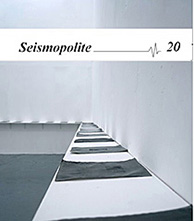Free Cultural Spaces: Freedom of Expression in Autonomous Geographies
Written by Tina Carlisi
“Together we may find some of what we’re looking for—laughter, beauty, love, and the chance to create.” —Saul Alinsky (1971, xxvi).
What is the relationship between autonomous spaces,[1] communalising and freedom of expression? As cities face crucial issues directly related to gentrification, reduction of public or free spaces, and an increase in state and corporate surveillance and control, how can artists cultivate strategies for freedom of expression through autonomous ways of living and working? This essay explores links between autonomy and freedom of expression by considering examples of autonomous communities where artists and cultural workers actively seek to open and provide free cultural spaces[2] for creativity, solidarity and exchange.
In studying examples of intentional communities, from those established during the counterculture of the 1960s and ’70s to more contemporary examples of autonomous social experiments in Copenhagen and Amsterdam, this essay proposes that vital lessons can be drawn from communes and squatters’ movements in relation to politically and socially engaged contemporary art practices. Alternative milieus offer living evidence of the direct correlation between free spaces and freedom of expression, which in such spaces is broader and less constrained by social, economic and cultural pressures.[3] Furthermore, free cultural spaces also provide a fertile ground for experiencing transformative social, political and creative connections in lived, unmediated ways.
Christiania: A Longstanding Freetown
In 1971, a group of squatters, hippies, artists and activists broke into a recently abandoned military barracks on eighty-four acres of land in the centre of Copenhagen, marking the beginning of a longstanding experiment in community known as Freetown Christiania. In the fall of that year, an alternative weekly newspaper published an article on Christiania, inviting people seeking housing to go to there. Within days, hundreds of people took the risk and moved into the area. This made it difficult for authorities to evict the residents—more than seven hundred people—which prompted the new liberal Danish government to allow the intensively squatted zone to exist as a social experiment (Lauritsen 2002).
Though it seemed unlikely in its early days, over its forty-seven years of existence Christiania developed into an alternative model for freedom of expression in everyday life. Although it is not strictly known as an artists’ town, many Christianites evidently “live artistically” (Lillesøe 2016)—in a manner, in other words, whereby they can freely express themselves in their everyday lives. Christiania as a living example of an alternative society for Copenhagen and Denmark at large, safeguarding the notion that the creation of free spaces for everyday life is central to autonomous movements (Katsiaficas 2006). Since the counterculture, moreover, intentional communities established through or connected to squatting have emerged and continue to emerge, representing possibilities for fostering a network of support for free cultural spaces that extends beyond local geographies.
Ruigoord: An Enduring Free-haven
Ruigoord, to the west of Amsterdam, is a significantly smaller land occupation than Christiania that has been home to a group of artists and writers since 1972. Ruigoord used to be a small village comprised of about a hundred houses and a church along the harbour, surrounded by farmland and forest. In the early 1970s, the Dutch government decided to expand the industrial harbour, forcing Ruigoord’s five hundred residents to sell their houses to the state, with the intention of completely demolishing the village to make way for industry[4] (van Riemsdijk 2013). Only a handful of protesting residents remained. In 1972, a group of artist hippies connected to the Provo movement, based chiefly in Amsterdam since the sixties, decided to squat the homes and lands left behind. Original residents were not thrilled with their squatting artist-neighbours, but tolerated them, since their efforts to protect the green area had saved the village from demolition (ibid.)
Due to the oil crisis of the 1970s, the Dutch government suspended its expansion plans, which attracted more artists, writers and other free spirits from the city centre to squat the empty houses. Artists saw Ruigoord, with its natural setting, as a pastoral paradise—an idyllic enclave and an alternative to the busy city life (ibid.). The harbour company continued to expand, taking over more of the surrounding farmland and forest, until the industrial land extended to just a few metres short of the village’s edge. Squatters continued to employ protest tactics throughout the nineties, until the government finally decided to legalize Ruigoord (Rovics 2013). Completely surrounded by industry, the community could no longer live permanently on the area’s single patch of green land; therefore, residents decided to convert their former homes into artist studios and offer art classes (Ruigoord 2017). The original church, handed over to the artists by its priest back in the seventies (Amsterdam Museum n.d.), continues to be the main cultural hub, with weekly festivals and activities available for free to the wider Amsterdam community.
Interdependence Between Autonomous Communities
Artistic connections have existed between Christiania and Ruigoord, especially in earlier years via the experimental theatre groups Amsterdam Balloon Company, in Ruigoord, and Solvognen, in Christiania. The Amsterdam Balloon Company describes itself as “an artist collective rooted in the tradition of happenings and based on friendship and a common sympathy for the fantastic and revolutionary arts” (ABC n.d.). The troupe would organize an annual festival in Ruigoord, which at the time connected other avant-garde artists across Europe. The week-long festival included concerts, poetry, dancing, flying kites and happenings (van Riemsdijk 2013).
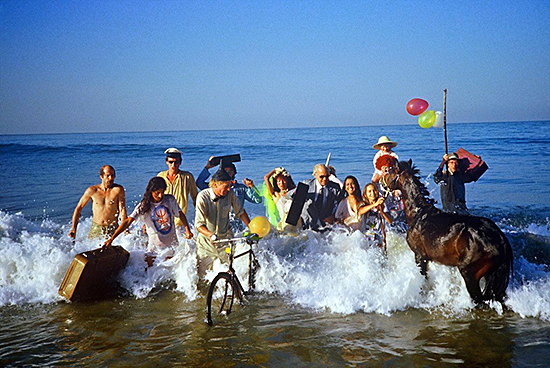
Solvognen, which means “Chariot of the Sun”—a reference to Norse mythology—was an action theatre collective active between 1969 and 1983. Made up of activists against the war in Viet Nam, squatters, hippies and yippies, some members moved to Christiania in the early 1970s. Gradually the troupe became an integrated component of Freetown, where they began their political action theatre (Jorgensen 1982).[5] In adopting a co-operative group work model and performing in the streets and other everyday places, the troupe presented an alternative to institutionalized theatre in Denmark at the time (ibid.; Garton 1983). Solvognen’s street theatre productions were large in scale, often involving hundreds of performers staging highly provocative political actions.
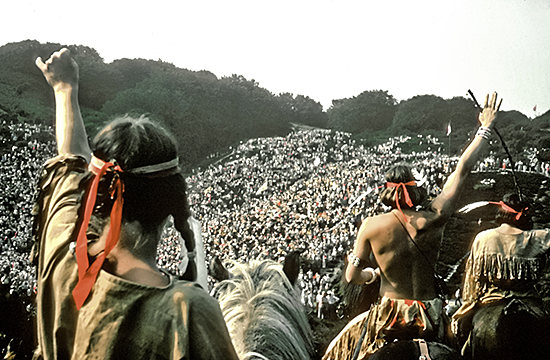
Christiania and Ruigoord are cultural free-havens[6] networked to other free-havens at the local, national and international levels. One event (amongmany) that provides such spaces for exchange is the annual Futurological Symposium, started in 2011. The Ruigoord community originated the idea for the symposium, which is based on the premise that “free and playful interactions between people generate powerful communal impulses” (Free Cultural Spaces n.d.). The Symposium promotes the preservation of free spaces for cultural exploration, as well as the awareness that their significance extends well beyond the communities, festivals, or projects directly involved in them. The importance of free-havens lies in their potential to transform participating individuals and society at large by sharing values and practices to “generate new and creative alternatives to mainstream culture” (ibid.).
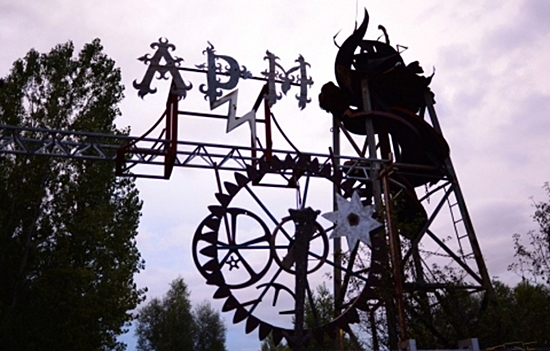
Free Cultural Spaces as Micro-Utopias
Over time, the older, countercultural autonomous artist communities have fostered solidarity and support, directly and indirectly, for more contemporary ones to emerge. ADM, a self-organized community based in an old, abandoned shipyard in an industrial section of Amsterdam (ADM n.d.), for example, was the site of the most recent Futurological Symposium. Despite currently being under threat of eviction, ADM has grown into a community of over a hundred artists since squatters first moved into the derelict shipyard in the nineties, and is united by values and practices similar to those of Ruigoord or other squats and free cultural spaces in the city. In Copenhagen, autonomous practices and social experimentation persist, as embodied in the autonomous project Flydende By (Floating City). Begun in 2008 and based in an industrial warehouse, the project is connected to an autonomous group that operates a culture house/free space called Bolsjefabrikken (Candy Factory) (Steiger 2011). Flydende By aims to spread awareness about waste by building boats from recycled materials for off-the-grid living (Flydende By n.d.). Using only up-cycled materials, Flydende By residents also use the warehouse to host DIY maker-space workshops and create public events that celebrate free creative expression. While the countercultural movements of the sixties and seventies in European countries like Denmark and the Netherlands benefitted from expanding welfare systems (Katsiaficas 2006; van Riemsdijk 2013), communities like ADM and Flydende By illustrate how free cultural spaces for free expression can continue to flourish against the grain of urban neoliberalization.
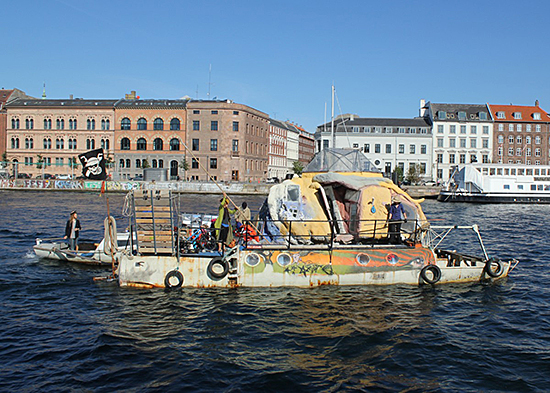
This essay focuses on just four communities in two cities—Christiania, Ruigoord, ADM and Flydende By—but many more examples exist of free cultural spaces in Europe in which strong traditions of autonomous cultures persist (SqEK 2012; 2014; Moore 2015; 2016; van der Steen et al. 2014; Vasudevan 2017). Radical histories and practices linked to squatting and commune cultures have been widely examined in the fields of urban studies, anthropology and sociology, yet scant literature exists that seeks to understanding such communities as spaces for free creative expression in relation to a broader discourse on contemporary art practices.
In one of the few essay collections to survey cultural production in occupied spaces, art historian and activist Alan W. Moore points out that
[s]quatting as a movement is continually interacting with the wider economy, and with institutions of all kinds. This is because squats and social centers produce within all the major fields of artistic vocation. Music, theater and circus, visual art, literature, rap and poetry, research and study, archiving and book-making, photography, cinema, architecture, fashion, mechanics and artisanship—all are represented in squats, usually by collective working groups. Emergent fields of cultural production are represented as well, e.g. media art and broadcast, computer hacking, and creative social practice. (Moore 2016, 14)
Moore observes that while squatting culture has continuing relationships to and interactions with mainstream artistic production, the latter almost never points to or acknowledges the work that takes place in these spaces (ibid.). These venues offer prospective spaces for experimentation, self-discovery and different forms of learning/re-skilling, which in turn provide inspirational models to learn from as artists, cultural workers, or art educators committed to imagining micro-utopias through politically and socially engaged art. Free cultural spaces that emerge from autonomous movements offer frameworks for collective creativity, carving out spaces for freedom of expression. Mirco-utopias are for social dreaming—in other words, for ways of seeing and approaching the world, which move toward social change and ultimately represent and embody that vision (Levitas, 2010). If micro-utopias may act as spaces for free expression, what might mainstream art practices look like if they adopted values, strategies and practices modeled after free cultural spaces?
It has become a commonplace view that utopian projects are hopelessly impractical, or dangerously idealistic, or both (Davis and Kinna 2009). The predominant reason for such a negative view is that critiques tend to focus on aspects of utopian tradition associated with quests for perfection or impossible futures, and “curiously omit those elements associated with encouraging greater imaginative awareness of neglected or suppressed possibilities for qualitatively better forms of living latent in the present” (Davis 2009, 73). By instead fostering autonomous spaces, strategies and practices centered on togetherness and free expression, in forms that lie outside of current institutional frameworks, perhaps we may create micro-utopias that are not only meaningful, but even essential places for free expression.
Tina Carlisi is an artist and PhD candidate in Fine Arts at the Concordia University, Canada.
Notes
[1] Autonomous Geographies,” a two-year joint geography research project of the University of Leeds and the University of Leicester, defines autonomous spaces as “spaces where there is a desire to constitute non-capitalist, collective forms of politics, identity and citizenship. These are created through a combination of resistance and creation, and a questioning and challenging of dominant laws and social norms” (Pickerill and Chatterton, 2006).
[2] A free cultural space is a topographically open space, whether located in a landscape or structure, a Freiraum (German: “free space”) that sustains countercultural values and traditions, such as happenings, pop-up festivals, gatherings and squatting movements (Waalwijk, 2016).
[3] With the exception of threat of eviction for squats that have not been legalized.
[4] Similar struggles continue today as embodied in protest land occupations against proposed airport projects like La ZAD (zone à defendre) near Nantes, France and Grow Heathrow in London, United Kingdom.
[5] Action theatre developed out of the happenings of the 1960s, and “involves an intervention in an already established situation, i.e. the audience and the authorities are forced into co-acting and thereby into revealing what is normally disguised by the accepted ideology” (Jorgensen 1982, 17).
[6] Cultural free-havens can take many forms, such as squatted communities, hacker communities, pirate radio collectives, eco-villages, communes, intentional communities, independent festivals and occupied areas.
Bibliography
Alinsky, Saul. Rules for Radicals: A Practical Primer for Realistic Radicals. New York: Random House, 1971.
Amsterdam Balloon Company (ABC). http://kenno.home.xs4all.nl/abc1.html
Amsterdam Museum. Ruigoord Portretten [Portraits of Ruigoord]. http://ruigoordportretten.wordpress.com
Davis, Laurence. “Everyone an Artist: Art, Labour, Anarchy and Utopia.” In Anarchism and Utopianism, edited by Laurence Davis
and Ruth Kinna, 73–98. Manchester: Manchester University Press, 2009.
Davis, Laurence, and Ruth Kinna. Anarchism and Utopianism. Manchester: Manchester
University Press, 2009.
Flydende By. http://flydendeby.org
Free Cultural Spaces. http://freeculturalspaces.net
Garton, Janet. “Book Review: Gruppeteater i Norde.” Theatre Research International 8, no. 1 (1983): 74–75.
Jorgensen, Aage. “Touring the 1970’s with the Solvognen in Denmark.” Drama Review 26, no.3 (Fall 1982): 15–28.
Katsiaficas, George. The Subversion of Politics: European Autonomous Social Movements and the Decolonization of Everyday
Life. Edinburgh: AK Press, 2006.
Lauritsen, Pernille W. A Short Guide to Christiania. Translated by Rudi Narine and Martin Jørgensen. Copenhagen: Aschehoug
Dansk Forlag A/S, 2002.
Levitas, Ruth. The Concept of Utopia. Bern and Oxford: Peter Lang, 2010.
Lillesøe, Britta. “Christiania Art and Culture.” In Making Room: Cultural Production in Occupied Spaces, edited by Alan W. Moore
and Alan Smart, 95–97. New York: Other Forms and the Journal of Aesthetics and Protest, 2016.
Moore, Alan W. Occupation Culture: Art and Squatting in the City from Below. Brooklyn:
Minor Compositions, 2015.
Moore, Alan W., and Alan Smart, eds. Making Room: Cultural Production in Occupied Spaces.
New York: Other Forms and the Journal of Aesthetics and Protest, 2016.
Pickerill, Jenny, and Paul Chatterton. “Notes towards autonomous geographies: creation, resistance and self-management as
survival tactics.” Progress in Human Geography 30, no. 6 (2006): 730–46.
Rovics, David. Have Guitar, Will Travel: Protest Travel Writing. BookBaby, 2013.
Ruigoord. http://ruigoord.nl
Squatting Europe Kollective (SqEK), ed. The Squatters’ Movement in Europe: Commons and Autonomy as Alternatives to
Capitalism. London: Pluto Press, 2014.
Squatting Europe Kollective (SqEK), ed. Squatting in Europe: Radical Spaces, Urban Struggles. Brooklyn: Minor Compositions,
2012.
Steiger, Tina. “Spaces of Autonomy in Copenhagen and Madrid.” Master’s thesis, Université Libre de Bruxelles, 2011.
van der Steen, Bart, Katzeff, Ask and Leendert van Hoogenhujze, eds. The City Is Ours:
Squatting and Autonomous Movements in Europe from the 1970s to the Present. Oakland: PM Press, 2014.
van Riemsdijk, Marjolijn. Assault on the Impossible: Dutch Collective Imagination in the Sixties and Seventies. New York:
Autonomedia, 2013.
Vasudevan, Alexander. The Autonomous City. New York: Verso, 2017.
Waalwijk, Aja . “The Emerging Network of Temporary Autonomous Zones (TAZ).” In Making Room: Cultural Production in
Occupied Spaces, edited by Alan W. Moore and Alan Smart, 72–83. New York: Other Forms and the Journal of Aesthetics and
Protest, 2016.









